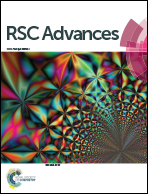Co-immobilized recombinant glycosyltransferases efficiently convert rebaudioside A to M in cascade†
Abstract
Rebaudioside M (Reb M), as a natural and healthy Stevia sweetener, is produced by two glycosyltransferases that catalyze the serial glycosylation of Rebaudioside A (Reb A) and Rebaudioside D (Reb D) in cascade. Meanwhile, it is of great importance in developing an immobilization strategy to improve the reusability of glycosyltransferases in reducing the production cost of Reb M. Here, the recombinant glycosyltransferases, i.e., OsEUGT11 (UGT1) and SrUGT76G1 (UGT2), were expressed in Escherichia coli and covalently immobilized onto chitosan beads. UGT1 and UGT2 were individually immobilized and co-immobilized onto the beads that catalyze Reb A to Reb M in one-pot. The co-immobilized enzymes system exhibited ∼3.2-fold higher activity than that of the mixed immobilized enzymes system. A fairly high Reb A conversion rate (97.3%) and a high Reb M yield of 72.2% (4.82 ± 0.11 g L−1) were obtained with a feeding Reb A concentration of 5 g L−1. Eventually, after 4 and 8 reused cycles, the co-immobilized enzymes retained 72.5% and 53.1% of their original activity, respectively, showing a high stability to minimize the total cost of enzymes and suggesting that the co-immobilized UGTs is of potentially signficant value for the production of Reb M.



 Please wait while we load your content...
Please wait while we load your content...